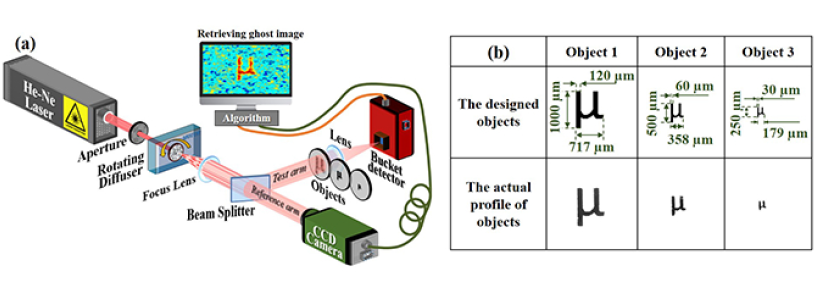Ghost imaging is a technique nonlocally produces an image of an object. The output of a (partially) coherent light source of the technique is split into two: one beam hits the unknown object while another severs as a reference and respectively record the photo fluxes of two beams to obtain spatial information of the object.
Pseudothermal light sources are commonly used in ghost imaging because of its experimental robustness and simplicity. However, the tradeoff between resolution and visibility is inevitable for high-quality imaging. Recent researches have been studied to balance disadvantages of the sources in macroscopic region but did not consider the width of object band below 200 μm. Are there some any methods to analyze the limitations in microscopic ghost imaging?
A research led by Dr. SUN Zhe from Xi'an Institute of Optics and Precision Mechanics (XIOPM) of the Chinese Academy of Sciences (CAS) teamed up with Germany scientists designed an experiment that control the speckle size employing an aperture to regulate the beam size of incoming sources. Using this technology, they firstly observed a scaling of the CNR different from that of previous experiments with increased speckle size. The results were published in OPTICS EXPRESS.
 Schematic of the microscopic ghost imaging experimental setup and used objects.(Image by XIOPM)
Schematic of the microscopic ghost imaging experimental setup and used objects.(Image by XIOPM)
In their scheme, Helium-Neon laser and rotating diffuser were used to generate a pseudo-thermal beam that different average speckle sizes can be obtained by changing the beam waist. Then, the generated speckle field is split into reference and reflected beams. Only if the propagation lengths of the two beams are the same, the ghost imaging with randomly distributed fields and few millimeters error can be possibly achieved.
Moreover, a numerical model that independently vary the relevant parameters over a wide range was designed to identify their role in the observed scaling of CNR for speckle sizes, which perfectly matched the experimentally observed sudden drops in CNR.
The discovery in this research will be of great importance in future experiments on microscopic ghost imaging in regulating the speckle sizes to obtain the best visibility and resolution of reconstructions.
Download: